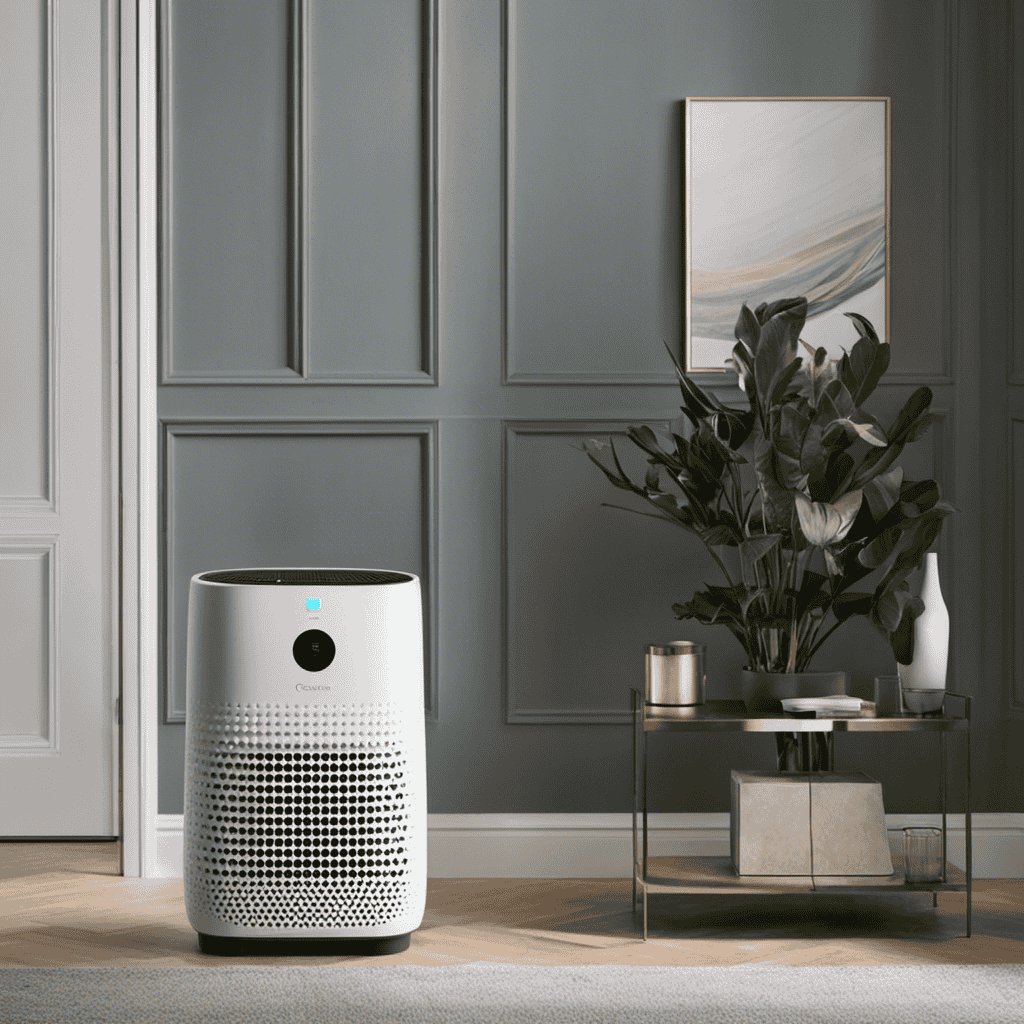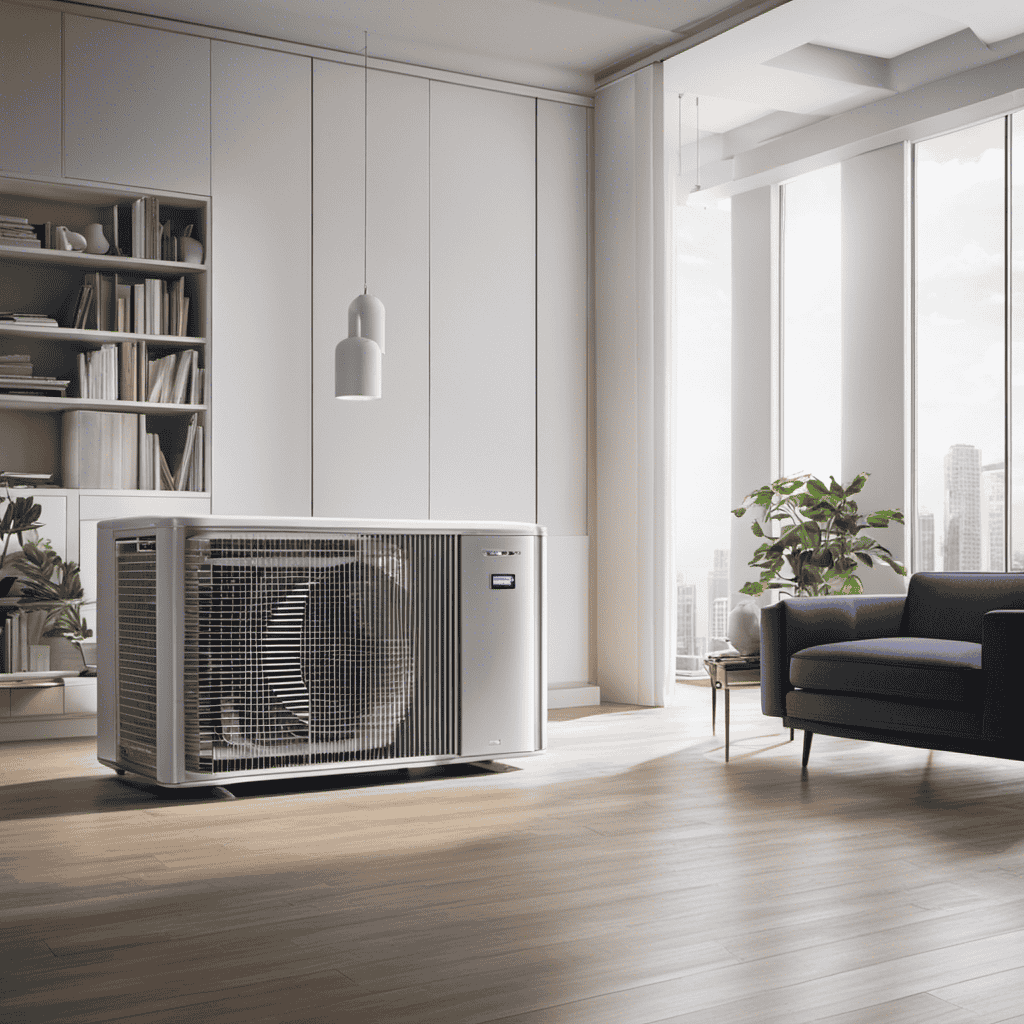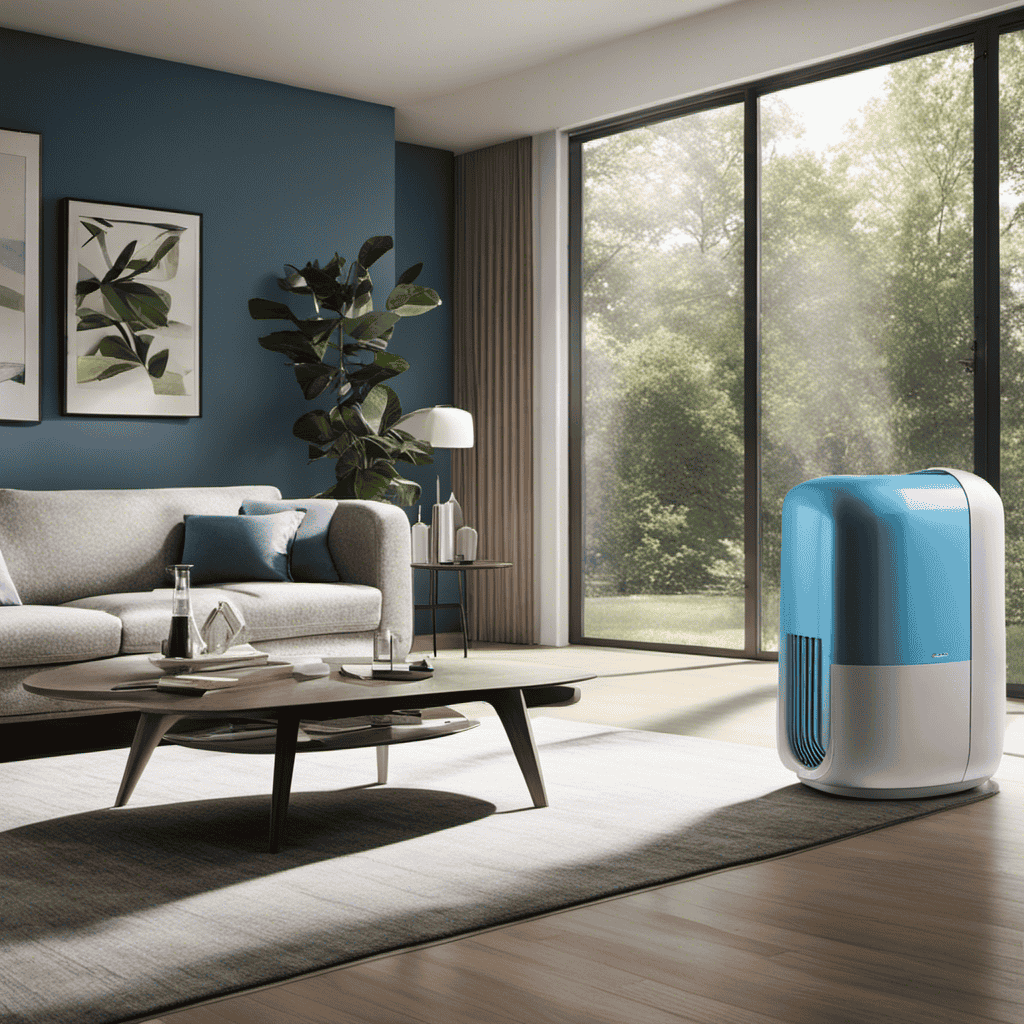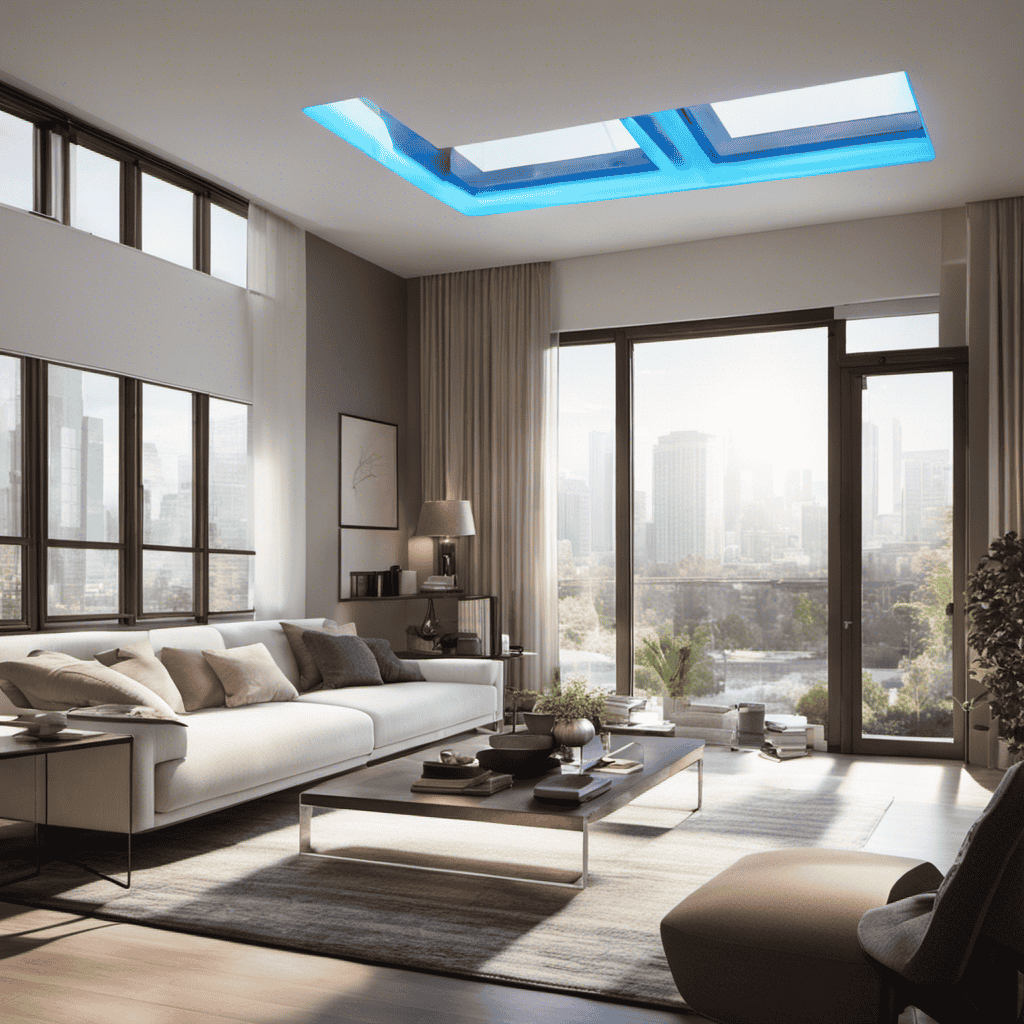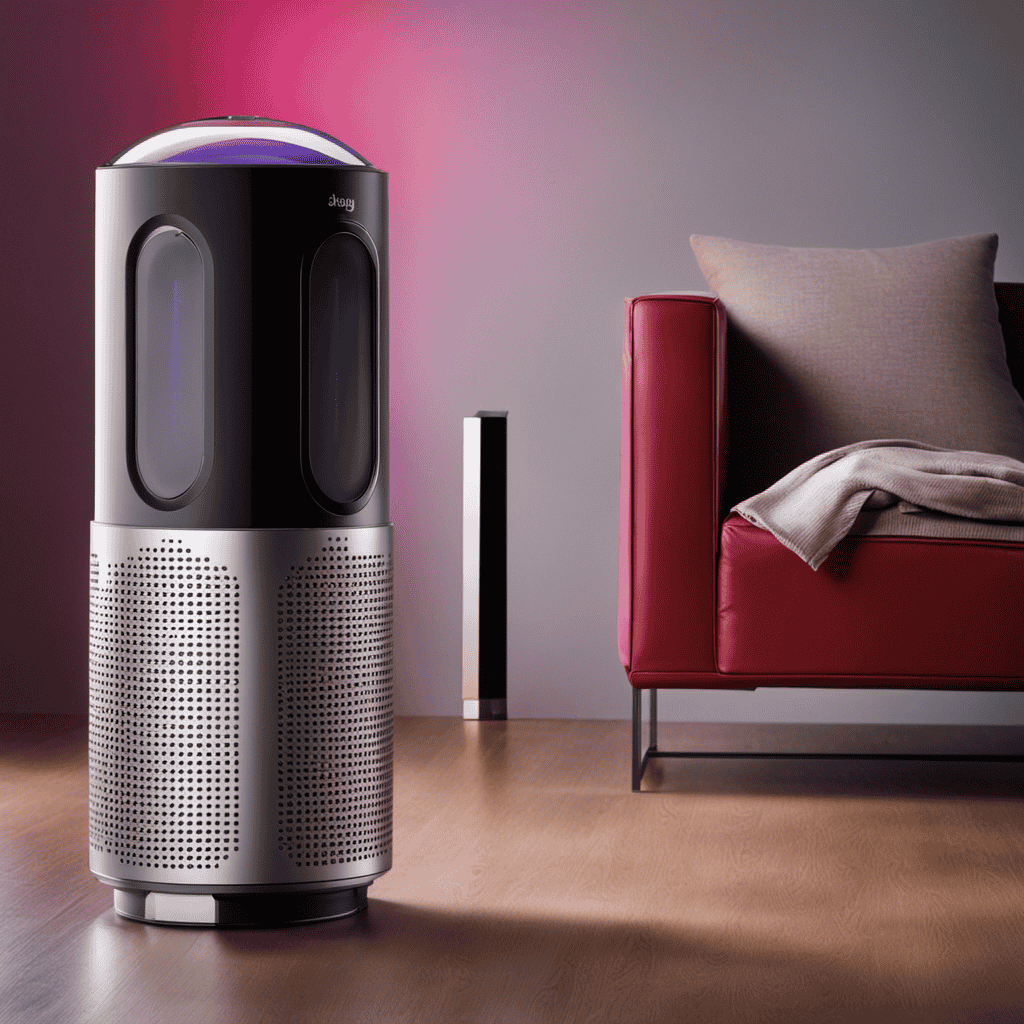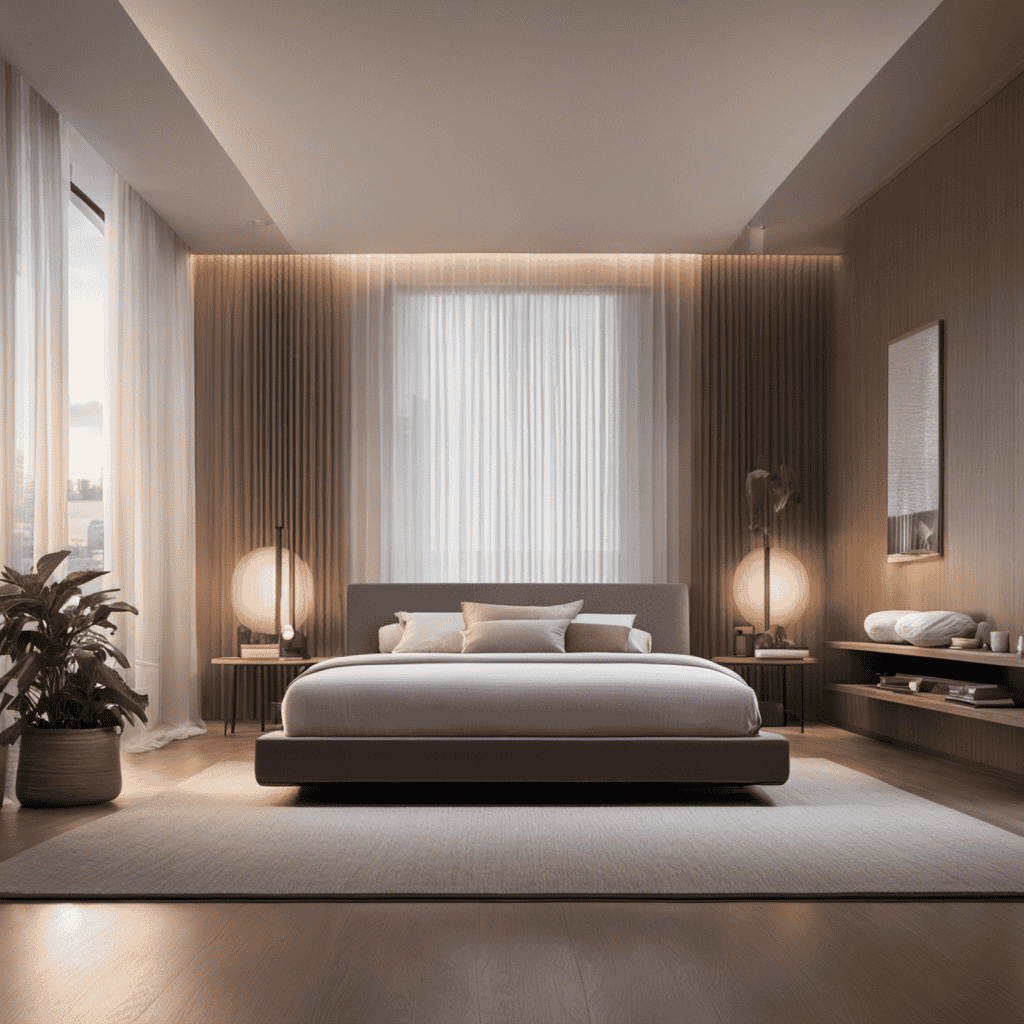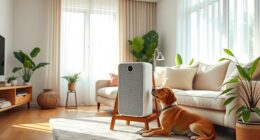When I enter a room, I am instantly greeted by a sense of freshness. The air is crisp, pure , and devoid of any impurities. How is this achieved? It is all thanks to the room air purifier.
In this article, I will take you through the inner workings of these remarkable devices. We’ll explore the filtration process, the types of filters used, and how air purifiers effectively remove pollutants from the air.
So, join me on this journey of understanding as we unravel the mystery of how a room air purifier works.
Key Takeaways
- Room air purifiers use filters to remove pollutants and allergens from the air.
- The filtration process involves multiple filters working together, including pre-filters, HEPA filters, and activated carbon filters.
- Air purifiers effectively remove a wide range of contaminants from the indoor environment, including dust, pet dander, pollen, mold spores, odors, chemicals, and volatile organic compounds (VOCs).
- Different types of filters are used in air purifiers, such as activated carbon filters and electrostatic precipitators, to ensure cleaner and healthier indoor air quality.
The Basics of Room Air Purifiers
Room air purifiers work by using filters to remove pollutants and allergens from the air. These devices are designed to improve indoor air quality by capturing and trapping particles such as dust, pet dander, pollen, and smoke.
Regular maintenance is essential for the optimal performance of an air purifier. This includes regularly cleaning or replacing the filters, as dirty filters can reduce the efficiency of the device. Additionally, it is important to regularly clean the exterior of the purifier to prevent the accumulation of dust and debris.
Using an air purifier can provide several benefits, such as reducing asthma and allergy symptoms, eliminating odors, and improving overall respiratory health. By removing harmful particles from the air, air purifiers create a cleaner and healthier living environment.
Understanding the Filtration Process
To understand the filtration process of an air purifier, you’ll want to know how different filters capture and remove contaminants from the air. Here’s a breakdown of how it works:
-
Pre-filter: This initial filter traps large particles like dust and pet hair, preventing them from clogging the other filters.
-
HEPA filter: High Efficiency Particulate Air (HEPA) filters are capable of capturing particles as small as 0.3 microns, including allergens, pollen, and mold spores.
-
Activated carbon filter: This filter uses activated carbon to absorb and neutralize odors, chemicals, and volatile organic compounds (VOCs) in the air.
By combining these filters, air purifiers can effectively remove a wide range of contaminants from your indoor environment. This not only improves air quality but also offers numerous benefits, such as reducing allergies, eliminating odors, and promoting better respiratory health.
To ensure optimal performance, regular room air purifier maintenance, such as replacing filters according to the manufacturer’s recommendations, is essential.
Types of Filters Used in Air Purifiers
When choosing an air purifier, it’s important to consider the different types of filters used and how they effectively capture and remove contaminants from the air.
One common type of filter used in air purifiers is the activated carbon filter. This filter is designed to adsorb or trap gases, chemicals, and odors. The activated carbon has a large surface area that allows it to effectively capture these contaminants, making the air cleaner and fresher.
Another type of filter used is the electrostatic precipitator. This filter uses an electric charge to attract and capture airborne particles. The charged particles are then collected on plates or grids within the purifier. These filters are efficient in removing larger particles, such as dust and pet dander.
With these different types of filters, air purifiers can effectively remove pollutants from the air, ensuring cleaner and healthier indoor air quality.
Now, let’s explore how air purifiers remove pollutants from the air in more detail.
How Air Purifiers Remove Pollutants From the Air
When it comes to removing pollutants from the air, air purifiers utilize various filtration mechanisms. These mechanisms work together to effectively capture and eliminate different types of air pollutants.
The types of air pollutants that can be filtered out by air purifiers range from common allergens like dust and pollen to more harmful substances such as smoke particles and volatile organic compounds (VOCs).
Filtration Mechanisms Used
Understanding how a room air purifier works can help you grasp the filtration mechanisms it employs to clean the air. Air purifiers are essential for maintaining clean and healthy indoor air quality, and regular maintenance is crucial to ensure their optimal performance.
Here are three key benefits of air purifiers and the filtration mechanisms they utilize:
-
Removal of airborne particles: Air purifiers use filters to capture and remove allergens, dust, pet dander, and other particles from the air.
-
Elimination of odors: Some air purifiers are equipped with activated carbon filters that absorb and neutralize unpleasant odors, such as cooking smells and pet odors.
-
Reduction of harmful gases: Air purifiers with HEPA filters can also trap and remove harmful gases, such as volatile organic compounds (VOCs) and tobacco smoke.
By understanding these filtration mechanisms, you can effectively maintain your air purifier and maximize its benefits.
Now, let’s delve into the various types of air pollutants that air purifiers can combat.
Types of Air Pollutants
To effectively combat air pollutants, you need to be aware of the different types that can circulate in your indoor environment. Indoor air quality is crucial for our health, as we spend a significant amount of time indoors.
Various pollutants can be present, such as particulate matter, volatile organic compounds (VOCs), carbon monoxide, nitrogen dioxide, and radon.
Particulate matter includes dust, pollen, pet dander, and mold spores, which can cause respiratory problems and allergies.
VOCs are emitted from common household products, like cleaning supplies and furniture, and can lead to headaches, dizziness, and even long-term health effects.
Carbon monoxide and nitrogen dioxide are byproducts of combustion processes, such as from gas stoves or heaters, and can cause symptoms like nausea, confusion, and chest pain.
Lastly, radon is a radioactive gas that can seep into homes from the ground and is a leading cause of lung cancer.
Understanding these different types of air pollutants is essential for maintaining good indoor air quality and protecting our health.
The Role of HEPA Filters in Air Purification
HEPA filters are essential in removing small particles and pollutants from the air in a room. They play a crucial role in air purification by trapping and eliminating harmful substances.
Here are three important points about HEPA filters:
-
High Efficiency: HEPA filters can remove up to 99.97% of particles as small as 0.3 microns, including dust, pollen, pet dander, and mold spores. This ensures cleaner and healthier air for you to breathe.
-
Activated Carbon: Many HEPA filters also include an activated carbon layer. This layer helps to absorb and neutralize odors, smoke, and volatile organic compounds (VOCs) that may be present in the air.
-
Allergy Relief: HEPA filters are highly beneficial for people with allergies or respiratory conditions. They can effectively reduce allergens in the air, providing relief from symptoms like sneezing, coughing, and congestion.
Maintaining and Cleaning Your Room Air Purifier
When it comes to maintaining and cleaning your room air purifier, two key points to consider are the frequency of cleaning and the proper cleaning techniques.
Regular cleaning is essential to ensure the optimal performance of your air purifier and to keep the air in your room clean and fresh.
Frequency of Cleaning
Regularly cleaning the filters in a room air purifier helps to maintain its effectiveness. It is important to clean the filters regularly to ensure the air purifier is functioning at its best. Here is the recommended frequency of maintenance for cleaning your room air purifier:
-
Monthly cleaning: It is recommended to clean the pre-filter and the activated carbon filter once a month. These filters capture larger particles and odors, respectively.
-
Quarterly cleaning: The HEPA filter, which removes smaller particles such as dust, pollen, and pet dander, should be cleaned every three months. This ensures optimal performance and prolongs the lifespan of the filter.
-
Yearly cleaning: The UV-C light bulb, if your air purifier has one, should be replaced once a year. This light bulb helps to eliminate airborne germs and bacteria.
Following these cleaning frequencies will help to maintain the efficiency of your air purifier and ensure that it continues to provide clean and fresh air in your room.
Proper Cleaning Techniques
To properly clean your air purifier, start by unplugging it from the power source.
Cleaning techniques for an air purifier typically involve removing and cleaning the filters, as well as wiping down the exterior.
Begin by carefully removing the filters, following the manufacturer’s instructions. Depending on the type of filter, you may need to vacuum or wash them. If washing, use mild detergent and warm water, and allow them to thoroughly dry before reinserting.
While the filters are drying, wipe down the exterior of the purifier using a damp cloth or sponge. Pay attention to any crevices or vents where dust and debris may accumulate.
Finally, once the filters are dry, reassemble the purifier and plug it back in.
Following these maintenance tips will help ensure optimal performance and longevity of your air purifier.
Frequently Asked Questions
Are Room Air Purifiers Safe to Use for People With Respiratory Conditions Such as Asthma or Allergies?
Yes, room air purifiers can be safe for people with respiratory conditions like asthma or allergies. They help reduce indoor air pollution, regardless of price range, by removing allergens and particles from the air.
Can a Room Air Purifier Eliminate Pet Dander and Odors From the Air?
Sure, a room air purifier is great for eliminating pet dander and odors. It’s amazing how effective it is at cleaning the air and providing the benefits of fresh, clean indoor air.
How Often Should I Replace the Filters in My Room Air Purifier?
I replace the filters in my room air purifier every 3 to 6 months. They last that long because they capture and trap particles like pet dander and odors, improving indoor air quality.
Can a Room Air Purifier Remove Viruses and Bacteria From the Air?
Yes, a room air purifier can remove mold spores and allergens from the air. It can also help reduce symptoms of respiratory infections like the common cold by filtering out viruses and bacteria.
Are There Any Potential Side Effects or Risks Associated With Using a Room Air Purifier for an Extended Period of Time?
Using a room air purifier for an extended period may have potential health risks and long-term effects. It’s important to consider these factors before relying on this device for clean air.
Conclusion
In conclusion, room air purifiers are like guardians of our indoor air quality, working tirelessly to keep us safe and healthy.
With their advanced filtration systems, these devices act as shields, trapping and removing harmful pollutants from the air we breathe.
The HEPA filters, like knights in shining armor, play a crucial role in this purification process, ensuring that even the tiniest particles are captured.
To maintain their effectiveness, regular cleaning and maintenance are essential, allowing these air purifiers to continue their noble mission of creating a clean and pure environment for us all.
